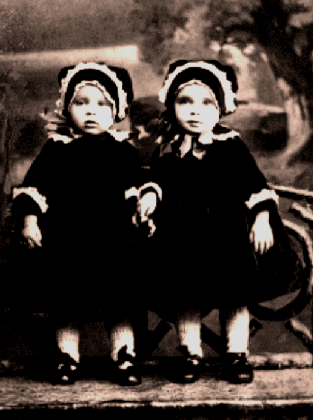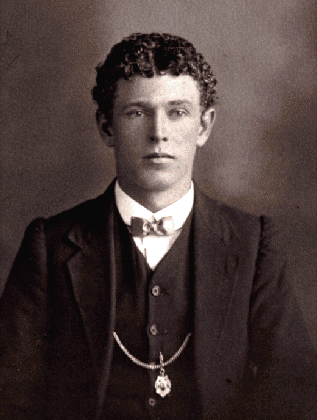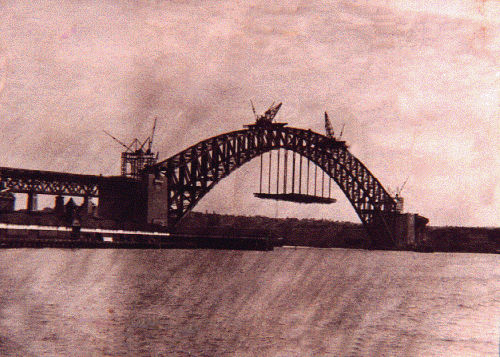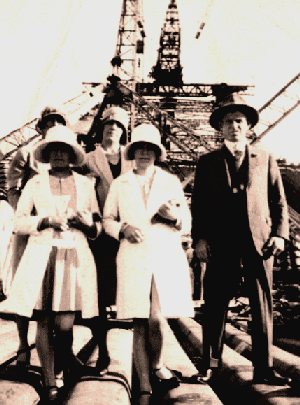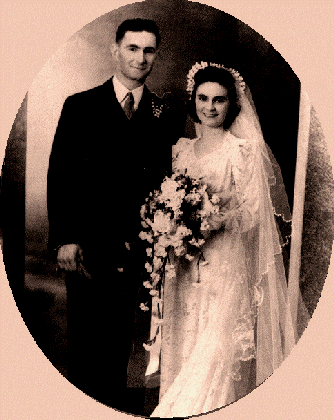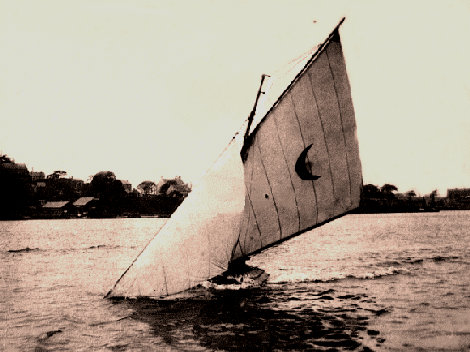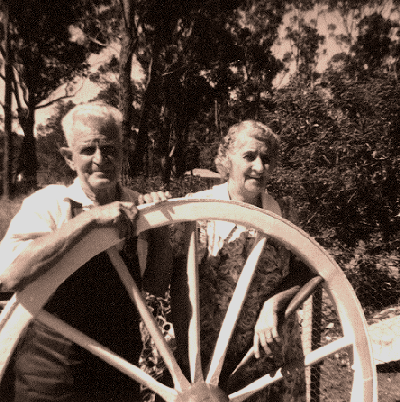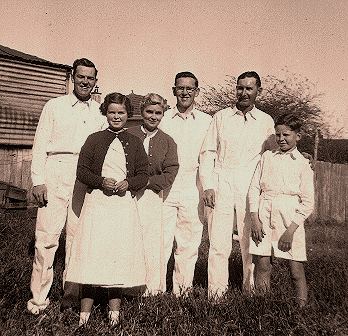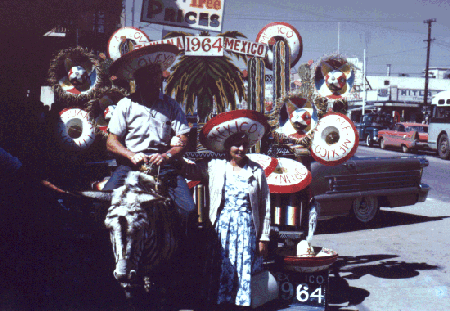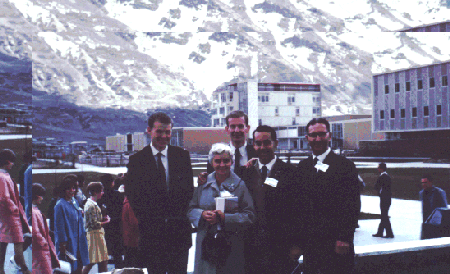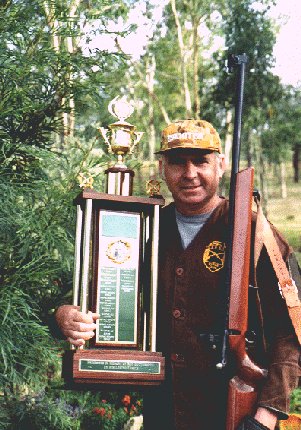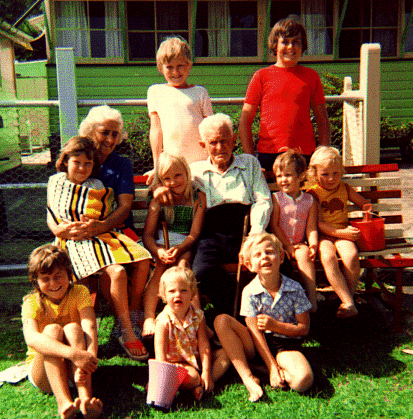 |
||||||||
Pearl and Thelma Ellis (twins) were born 3 January 1916, at Balmain, Sydney, New South Wales, to Thomas William Ellis and Ivy Pearl Haydon. They later had a brother, Thomas William Ellis born 6 May 1921. The following history of the Ellis family has been written by Pearl Ellis in 1997. My life began on 3 January 1916. Twenty minutes later my twin sister, Thelma, was born. Our mother was Ivy Pearl Haydon, and our father was Thomas William Ellis. When we were 5 years old our brother, Thomas William, was born, and named after our Dad. My mother’s great-grandparents came from Yelling, England, on the sailing ship "Una" in 1849. They were Samuel See (b. 1822) and Ann Cullip (b. 1823). Samuel was a coalminer, and went to work at the Newcastle Minmi and Wallsend mines in New South Wales. .
Left: ThomasWilliam Ellis, b. 1892. Dad was a boilermaker, and from all reports, was very good at his trade. He served his apprenticeship, along with three brothers, at Mort’s Dockyard in Balmain, Sydney, NSW. At 14 years of age I left school and was apprenticed to millinery. I was very fortunate, as at this time the big depression had been going on for about two years and jobs were hard to get. Dad was working only three days a week, as there were no ships being built at this time. He would pick fruit from our garden and try to sell it, but housewives could not afford to buy, so he would finish up giving it to them for nothing. At this time, he and two of his brothers were offered jobs on the Sydney Harbour Bridge (then being built), and worked there until the bridge was opened on 19 March 1932. The depression was still going on and a lot of people were hungry. O
We used to worry about him, as there were quite a few men killed. Right: The joining of the two spans of the Sydney Harbour Bridge. Below left: Tom and his family visit during the construction of the Sydney Harbour Bridge. He bought our first car (a Chevrolet), and still had quite a bit of money in the bank. Few men had a car in those days. For a while we had a great time, going on picnics and camping trips. One little anecdote which I will include here is of the time when Thelma and I were 5 years old, we used to play "mothers and fathers", and "doctors and nurses" quite a lot. One day Thelma had this great idea (or so we thought at the time). We found an old tin cutter
When Dad came home from work, he asked Mum why the tree was bandaged up, and told us we would have to take them off. Of course, Mum did not know about the bark part of it, as the tree was behind the fernery and she could not see what we were up too. Poor Dad, he was so mad when he found what we had done, but did not punish us, as he knew we did not know it was wrong. He sat down on a stool he had made and told us not to ever do that to any tree again, as now the tree would die and we would never get any more lovely nectarines off it. The tree subsequently did die. Looking back over the years, we had a wonderful childhood; we were never hit by our parents; only chastised with love. I have tried to be the same with my own children. After Dad finished work on the Sydney Harbour Bridge, he was offered a job in New Guinea working for an American firm, The Bulolo Gold Dredging Co. He did not want to leave home, but jobs were scarce. He still had money in the bank, and people could not get the "dole" in those days if they had money in the bank; it had to be spent first, and Dad did not want that to happen. In those days the dole was 3 days work a week for a mere pittance, with no choice of what you did. It was mostly road work. So he left the money in the bank for us to live on and took the job in New Guinea. He spent nearly six years in New Guinea, only coming home twice on holiday for 2 weeks each time. He was missed, but at least we were never hungry like so many other people were. Thelma worked as a dressmaker, and I was still in millinery. The wages were not high, but at least we had a trade. Thelma had been keeping company with Ira Ramsay, a schoolmate, for three years, and they were married in 1940. We were then 21 years old. I met Frank William Veness on a yachting picnic and fell in love then and there. We were married on 13 December 1941, and had two children, Margaret Frances (b. 1943), and Kevin John (b. 1945).
Our first home was at Kingsgrove; the war was over and home building was again under way. However, because of the scarcity of building materials, it was two years before it was finished. Me helping Frank build our house! I never really settled down at Kingsgrove, so we decided to move back to Ryde, nearer to my family. Frank built our home (with my help); it took 14 months of hard work to do so. Frank had a cousin who was a captain in the army. He told us that we should build an air-raid shelter in the back yard, as the Japanese were building up everywhere in the Pacific. At this time the war was getting very close to Australia, and every day the newspapers talked about the thousands of tons of our ships being sunk. Then Darwin and Broome were bombed by Japanese aircraft, so we decided to do as Keith had said and build the shelter. It was hard work digging the 7ft deep trench in the shale soil of our backyard, but in the end it was a very good shelter. We stocked it with some food, a lantern, a small methylated spirit stove, and blankets. We had lined it and roofed it and had seats for six people. We prayed that we would never need to use it, but one night the air raid sirens went off and while the rest of us went down into the shelter, Frank, Tom and Dad climbed up on the fence to watch our planes flying over Sydney Harbour looking for Japanese. The next morning we heard (on radio) that Japanese mini-submarines had entered the harbour, and that our navy had dropped bombs on them. We were glad we had the radio, as few people had them in those days. Dad had bought it to get first hand news about the war after we heard about the raids in Western Australia. Thank heavens we never did need the shelter. Dad loved sailing, and used to skipper a 6-foot boat, "Gwen", for a man who lived at Abbotsford. We all used to go across the Parramatta River in a punt to watch the races every Saturday during the summer months.
He also sailed in the 18-foot skiffs on Sydney Harbour, and then we would picnic at Bradley’s Head to watch. My brother, Tom, used to love to see him race. Right: Tom Ellis racing his 6ft skiff on Sydney Harbour. When our children were 2 and one month old respectively, Frank had to give up his job at the iron foundry, as he began to have health problems. He had been at the moulding trade for 12 years, working in a dirty factory. I was always worried about him working there. His father managed to get him a job as a carpenter in the Dept of Education. He liked the work, as he had always wanted to be a cabinet maker, but had to be content with the moulding trade as it was all he could get during the depression. He had wanted to join the army, as two of his brothers had already gone to war, but was rejected because he was making tank parts at the foundry. For this I was thankful. About this time my Mum and Dad went to live on Dangar Island in the Hawkesbury River.
Dad had the house built a few years before, and had planned to retire there when he reached 65; but with careful saving he was able to retire at 59. The house at Dangar was to become a focal point for both mine and my sister’s families. Dangar Island is a beautiful little island in the middle of the Hawkesbury River, reached by ferry or private boat. The beach in front of what was their house is used for the start of the now famous bridge-to-bridge ski race held each year. Left: Tom and Ivy Ellis as their home on Dangar Island in the Hawkesbury River. In 1956 two missionaries from the Church of Jesus Christ of Latter-Day Saints came to our home and taught us about the Gospel. Three months later we were all baptised. This was on 25 August 1956, Frank’s birthday. Frank was called and ordained a Bishop on 1 December 1963 by Joseph Fielding Smith. In 1964 Frank was given the opportunity to attend the April Conference in Salt Lake City, Utah. We both decided that I should go with him and make it our world trip. We went to the European Temples as we travelled through the Continent, and had a really wonderful time.
We now live in Western Australia after having spent 6 years on a citrus orchard at Mt White in New South Wales. Margaret’s husband and Frank were in partnership on the orchard, and although it was hard work, we really enjoyed that part of our lives. Right: Photo taken at Bankstown Chapel on our baptism day, 25th August, 1956. After selling the farm we all bought caravans and headed west. Frank and I were only coming for a holiday, but stayed. It was thought that WA would give our grandchildren a better start in life, and this proved to be true. It is now 1997, and we have been here for 22 years and have enjoyed it all. For the last six of these years we have been living in Mandurah, just south of Perth. Our son, Kevin, and his family left the west to settle in the Kingaroy district of Queensland, but comes home periodically to visit, and we make trips every few years to the Eastern States and Queensland. With his son, Christopher, now mrried and working in Bourke, in the west of New South Wales, and daughter, Michelle, presently living at Kurri Kurri, New South Wales, the family is spread far and wide. (Pearl died at home in Thornlie, WA, on 10th February 1999. She was buried 15 February 1999 at Pinnaroo Memorial Cemetery, Padbury, Western Australia.) |
||||||||
|
||||||||
|
||||||||
|
||||||||
|
||||||||
|
||||||||
